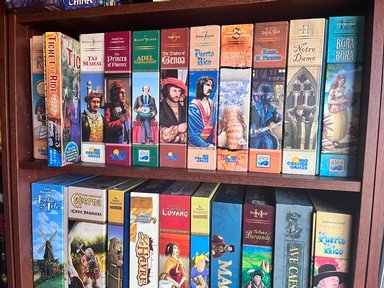Quiz Answer Key and Fun Facts
1. In Farkle, there are many possible dice combinations--sets, straights, etc. What happens when you get a farkle?
2. In Zombie Dice there are three pictures that appear on the thirteen dice: brains, footsteps, and shotgun blasts. Which picture do you most want to see on your dice?
3. In Machi Koro, you are trying to use dice to build up the town of Machi Koro (of which you are the titular mayor). Your town starts off small. Which working establishment or establishments do you begin with in the game?
4. In King of Tokyo, you roll dice to enable your monster to defeat the monsters controlled by other players. On a given turn, you monster is either inside Tokyo or outside Tokyo. Which die roll does not benefit you inside Tokyo?
5. In Stone Age, you are improving your prehistoric tribe in a variety of ways. One way is gathering resources--food, wood, brick, stone, or gold. With the exception of food, what is the maximum number of workers that you can send to gather a particular resource on a given turn?
6. In Qwixx, the game begins with players rolling a set of six dice (although the number may drop during the game)--two white dice and one die each in red, blue, yellow, and green. Which action can a player take on any turn?
7. In Left Center Right, each player starts with three chips. On a player's turn, the player rolls three dice that are marked on each side with either L, C, R, or a dot. Which symbol would you most want to see face up on your roll?
8. In Yahtzee, each player takes turns trying to achieve one of thirteen scoring combinations. Which scoring combination is worth the greatest number of points (without extra bonuses)?
9. In backgammon, you use dice rolls to move your pieces around the board. According to the traditional rules, what is the maximum number of your pieces that you can move on one turn?
10. In Boggle, the dice do not have the usual pips. What feature is seen on the dice instead?
Source: Author
bernie73
This quiz was reviewed by FunTrivia editor
WesleyCrusher before going online.
Any errors found in FunTrivia content are routinely corrected through our feedback system.

